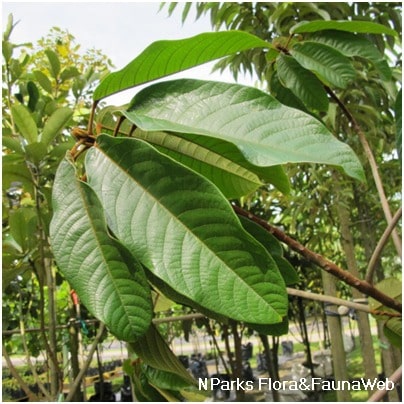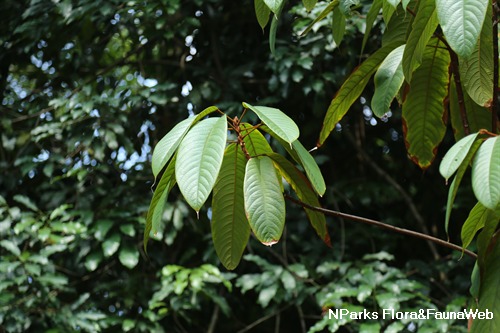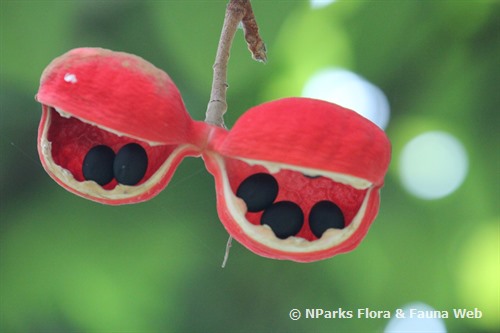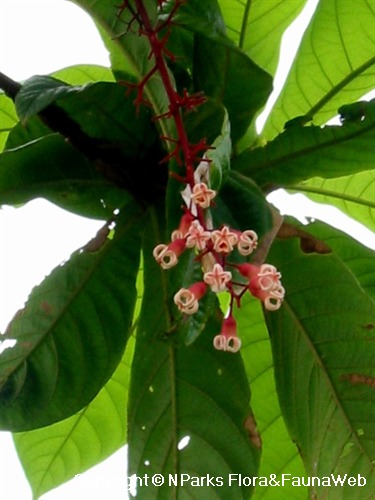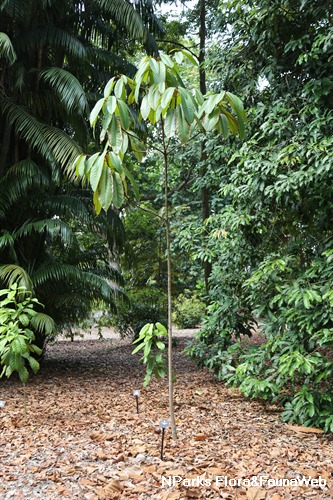
Back
Sterculia megistophylla Ridl.
| Family Name: | Malvaceae |
| Synonyms: | Sterculia hosei Merr. |
| Common Name: | Kalumpang, Buah Ayan Antu Sebayan, Biris Merah |
Name
Classifications and Characteristics
| Plant Division | Angiosperms (Flowering Seed Plants) |
|---|---|
| Plant Growth Form | Tree (Medium (16m-30m)) |
| Lifespan (in Singapore) | Perennial |
| Mode of Nutrition | Autotrophic |
| Plant Shape | Irregular |
Biogeography
| Native Distribution | Malay Peninsula, Sumatra, Borneo (Sarawak & Sabah). |
|---|---|
| Native Habitat | Terrestrial |
| Preferred Climate Zone | Tropical |
| Local Conservation Status | Non-native |
Description and Ethnobotany
| Growth Form | It is a tree, up to 20 m tall, with stout, hairy twigs. |
|---|---|
| Trunk | The outer bark is orange-brown and smooth. |
| Roots | It forms low, rounded buttresses. |
| Foliage | Its alternate, spirally arranged, stalked leaves are elliptic, elliptic-oblong, obovate or oblong obovate, 25-36 cm long by 8-18 cm wide, papery to leathery, hairless on the upper surface except for the mid-rib which is hairy, lower surface densely hairy. Leaf tip long and pointed, leaf base subcordate or round. The leaf stalks are covered with dense reddish hairs. |
| Flowers | Its densely hairy, brownish pink flowers are small, 1.5-2 mm long by 2-2.5 mm wide, borne on pendulous, cauliflorous, hairy inflorescences that are 15-30 cm long. Male and bisexual flowers are produced. |
| Fruit | Its fruits are beaked, oblong follicles that are 15-22 cm long by 5-7 cm wide, brilliant red or dark orange in colour, densely velvety on the outside and hairless or slightly hairy inside, bearing 15-20 dark green to brown ellipsoid seeds, 2.5 cm by 1.5 cm. |
| Habitat | It grows in lowland to submontane primary forests, from sea level up to 1500 m altitude. |
| Associated Fauna | Its flowers are insect pollinated. The seeds are dispersed by small mammals or birds. |
| Cultivation | It can be propagated by seeds. |
| Etymology | Latin stercus (derived from Greek Sterculius, god of fertilization), dung, referring to the smell of flowers; Greek megistophylla, largest or biggest leaf, referring to the large leaves of this species. |
Landscaping Features
| Landscaping | It is suitable for growing on roadsides and in parks. |
|---|---|
| Desirable Plant Features | Ornamental Flowers, Ornamental Foliage, Ornamental Fruits |
| Landscape Uses | General, Suitable for Roadsides, Parks & Gardens, Shade Providing Tree / Palm |
Fauna, Pollination and Dispersal
| Fauna Pollination Dispersal Associated Fauna | Bird-Attracting |
|---|---|
| Pollination Method(s) | Biotic (Fauna) |
| Seed or Spore Dispersal | Biotic (Fauna) |
Plant Care and Propagation
| Light Preference | Full Sun, Semi-Shade |
|---|---|
| Water Preference | Moderate Water |
| Plant Growth Rate | Moderate |
| Rootzone Tolerance | Moist Soils, Well-Drained Soils, Fertile Loamy Soils |
| Propagation Method | Seed |
Foliar
| Foliage Retention | Evergreen |
|---|---|
| Mature Foliage Colour(s) | Green |
| Mature Foliage Texture(s) | Hairy / Hirsute, Papery, Leathery |
| Foliar Modification | Stipule |
| Foliar Type | Simple / Unifoliate |
| Foliar Arrangement Along Stem | Alternate, Spiral |
| Foliar Attachment to Stem | Petiolate |
| Foliar Shape(s) | Non-Palm Foliage (Obovate, Elliptical, Oblong) |
| Foliar Venation | Pinnate / Net |
| Foliar Margin | Entire |
| Foliar Apex - Tip | Acuminate, Caudate |
| Foliar Base | Rounded / Obtuse, Cordate |
Non - Foliar and Storage
| Trunk Type (Non Palm) | Woody |
|---|---|
| Bark Colour(s) | Orange brown |
| Mature Bark Texture | Smooth |
| Root Type | Aboveground (Buttress Root) |
Floral (Angiosperm)
| Flower & Plant Sexuality | Unisexual & Bisexual Flowers(Sub-dioecious) |
| Flower Colour(s) | Pink |
|---|---|
| Flower Texture(s) | Hairy / Hirsute |
| Flower Grouping | Cluster / Inflorescence |
| Flower Location | Cauliflorous |
| Inflorescence Type | Raceme, Panicle |
Fruit, Seed and Spore
| Mature Fruit Colour(s) | Orange, Red |
|---|---|
| Mature Fruit Texture(s) | Velvety / Furry / Tomentose |
| Fruit Classification | Simple Fruit |
| Fruit Type | |
| Mature Seed Colour(s) | Brown, [Remarks] (Dark greenish) |
| Seed Quantity Per Fruit | Several (11-20) |
Image Repository
Others
| Master ID | 31269 |
|---|---|
| Species ID | 5664 |
| Flora Disclaimer | The information in this website has been compiled from reliable sources, such as reference works on medicinal plants. It is not a substitute for medical advice or treatment and NParks does not purport to provide any medical advice. Readers should always consult his/her physician before using or consuming a plant for medicinal purposes. |

